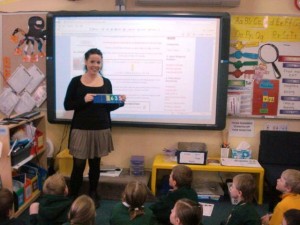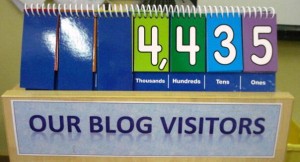This post marks another milestone on this blog
A huge thank you for all your support! More than two years later, I am still enjoying writing this blog more than ever due to the wonderful community of readers and supporters I am a part of.
I use ClustrMaps to keep track of visitors both on this blog and on my class blog. I also use Google Analytics which provides some excellent data but that is another blog post!
ClustrMaps is something we use as a powerful teaching tool in our classroom.
Kelly Jordan and I start every day by looking at our class blog together with our students on the interactive whiteboard. One of the first things we do is check out our ClustrMap. Our grade two students love seeing how our visitor total is progressing.
Our ClustrMap check offers so many teachable moments.
We have seen our students’ understanding of place value increase by this daily authentic activity. We use a place value chart to keep track of our visitors and every day we talk about how many thousands, hundreds, tens and ones are in our visitor number.
The students are able to apply the strategies we’re learning in maths to make predictions and calculations about our visitor count. It is a great chance for students to be able to share their strategies about how they worked out a problem (eg. how many more visitors will we need to get to 8000?).
Maths isn’t the only focus when we visit our ClustrMap. The red dots on the map and current country totals provide an authentic avenue to teach and discuss geography. We talk about what countries and cities most of our visitors are coming from and theorise why this is the case.
Our seven and eight year old students are becoming familiar with the world map and are developing an understanding of our place in our global society.



I use data in much the same way as you have demonstrated. I have my data up on the wall in the hall. We also have a ‘postcards and capitals’ display. This links postcards we receive with flags and countries and then we add in capitals of the world. When I was little I loved collecting stamps, now I am a big boy I collect flags! The children love finding which flag belongs to which country and they like learning the names of the capitals. I am going to have a break time quiz soon and I think the staff will be hammered! I have a team of updaters for USA, we’d love to collect all 50 states up until now we have 32. My American geography, literally has a long way to go.
It’s lovely referring to the BIG maps, thinking about continents and generally discussing geo/politics with very young people. My friend Rhys(aged 5), reminded me we, “can’t finish assembly yet…we haven’t done that flag!”It was Tunisia, I went for dates rather than the current revolution!
Mr E
Hawes
@ Mr E,
Thanks so much for your comment. Also, thank you for your great comment on our class blog. The kids were fascinated that you say “loads of” instead of “heaps of” – the small things really are fascinating aren’t they!
Your postcards and capital displays sounds like a great authentic learning experience! I’m sure my kids would love that. Kids are funny with routines like that aren’t they. They’re the first to point out when you forget something!
Kathleen
Hi Kathleen,
I can’t wait to share this with some of the primary teachers! Authentic learning in math for larger numbers was such a difficult concept for them to learn and for me to teach. My first full time job was a 2nd grade teacher — and I struggled with this concept… and would bring in 1000 Cheerios or would make 1000 dots on a page… This is much more relevant.
How does Google Analytics work? I’ve read about it, almost tried venturing into it, but talked myself out of it. Do you have any tips for someone who only knows it by name, but wouldn’t even know where to look for it/how to use it?
Kind regards,
Tracy
@ Tracy,
Thanks for your comment. I’m so glad you find the use of ClustrMaps useful. As always I think I originally got the idea from Linda Yollis! You’re right, teaching about large numbers is so hard for some kids and I have tried everything too! I can see a clear difference in the place value knowledge of my kids this year compared to previous years.
As for Google Analytics I suggest you read these two posts Sue Water’s wrote
http://theedublogger.com/2008/06/12/the-basics-of-using-google-analytics/ and
http://theedublogger.com/2008/06/05/setting-up-google-analytics-on-your-blog/
Took me a while to get the hang of but the data is interesting!
Kathleen
Hi Kathleen,
Thanks! I’ll be sure to check those links out.
Regards,
Tracy
@David, that is a great idea with the flags, my students love flags!
@Kathleen I agree that the experience of learning their place in this global society is such an important impact we can have on our students, and ClustrMaps is so perfect for that.
We are only half of a term into our blogging and by far, the ClustrMap has been the tool that has had the most teachable moments. I have been amazed by the power of the ClustrMap.
As a language teacher, it has been an authentic tool for global exploration. From preps to grade 6 they have all expanded their sense of the world unbelievably. To see where Australia sits in the world in such an authentic way is invaluable. And to see some dots from Spain and Mexico have really made them want to do their personal best in their work that may go up in the blog. Seeing that they have a “real” Spanish audience for their work is such a catalyst to do more and better! They also have explored where other Spanish speaking countries are and how they could get some dots from there.
Like you Kathleen, we have also used it to theorise why we have dots from certain countries and where we would like to see some dots from. We have also looked at the 2KM and 2KJ blog to see how many visitors you have and how if we work really hard on our blog, we might have that many visitors someday!
Similarly to your experience with Maths, we have used it for counting in Spanish. Everyday we start class by checking the numbers of where people come from and learning them in Spanish. At the moment it is great because apart from Australia we have fairly small numbers so they all know how to say them, but as the numbers get greater it will give them a real reason to want to learn the higher numbers.
We are also learning the names of the countries that we have dots from in Spanish.
All in all, I adore ClustrMap and the authenticity it brings to the classroom but also the catalyst to make them want to do their personal best.
@ Aine,
Wow! This is all amazing and I didn’t realise how many ways blogs and ClustrMaps could be used in a LOTE classroom. I think you should start running PDs for LOTE teachers soon!
How fantastic to be able to see if you have a Spanish audience looking at your Spanish blog! I love the way you say your visitor numbers in Spanish – this is certainly an authentic motivation for the kids!
If you ever feel like doing a guest post on this blog about using blogs or technology in LOTE that would be fantastic!
Kathleen
@ Mrs Morris,
We shure do have a lots of visitors! 🙂
You and Miss Jordan are so nice teachers. 🙂
Love From,
Kayla 😛
@ Kayla,
Thanks for your comment. It is always nice to hear from students.
Mrs M☀rris
Hi Kathleen,
We use our Clustr Map very similar to you also. We check estimate our number of visitors every morning, and then calculate how many we’ve had since the previous day (even though it lists that data!). We then update our blog wall, which is filled with flags of the countries we’ve had visit us. We check for new countries listed, and then Google where they actually are.
The other day we used the data to estimate when we’d reach 1000 visitors! It was a great open ended task, using lots of skills!
With our ‘dots’, we look at where they are, and then guess why they’d be that size, eg. The Classroom Connection or another blogging buddy in that location.
Parents have also commented on kids’ geographical knowledge since having the blog, so that’s always great to hear!
The students LOVE checking the Clustr Map!
Thanks Kathleen,
Kirby
@ Kirby,
Thanks for sharing how you use Clustrmaps, it sounds fantastic. I’d love to start the flag routine that you and Mr E described.
Like you, we like estimating how long it will take to get to our next thousand. It’s tricky for the grade twos but a very rich task!
Kathleen
Kathleen,
I ♥ ClustrMaps and have used them in a variety of ways. Here are a couple of fun blog posts using ClustrMap data:
ClustrMap End-of-the-year Cake! I saw this idea on a class blog, but can’t remember which one. ☹
Sometimes the visitor count is an interesting number. ClustrMap Palindrome The comment section on this one turned out to be so much fun!
Here I used the actual maps for a lesson. I even learned some new terms from this post! Mr. Webb informed me that Australia and New Zealand are called Australasia. I’m embarrassed to say it, but that was a new term for me. ClustrMap Screen Shots of Maps
The ClustrMap can provide so many teachable moments! As you can see in two of the above links, we break down the visitor count number every day. It is always displayed in standard form, word form, and expanded form. As you said, this regular practice with place value really improves a student’s understanding of numbers.
Thanks for another fabulous post, Kathleen!
@ Linda,
Thanks so much for your comment. As I said to Tracy, I think I got the idea of the place value counter off you! I’m a firm believer that explicit, authentic and regular practice of important concepts like place value are necessary to develop the students’ understandings. You’ve just given me a new idea – we need to do more work on expanded form and number form! It is easy to just focus on the numbers most of the time. Thanks, Linda!
That Clustrmap cake was absolutely magnificent! Didn’t you get a Clustrmap mug or something as a gift once too?
Like always, I genuinely appreciate your thoughtful comments!
Kathleen
Dear Mrs Morris,
You must be busy all night are you?
Keep the good work Mrs Morris!
See you tomorrow.
Love,
Keira.
@ Keira,
Thank you so much for your comment. It is always nice to hear from one of my students!
Best wishes,
Mrs M☀rris
@ Mrs Morris,
Thank you for replying to me how nice is it.
I wish I could leave more comments but I have got to read to my sister.
Love from,
Keira. 😆
I appreciated reading about how you and your students use your clustr map in the classroom — what a great way to make learning maths and geography fun!
I have given you another red dot for you map — this time, it’s from Germany!
[…] quick mental maths problems. Keep a track over a week and see what the difference is. (Thanks to Kathleen Morris’s post for ideas […]
[…] quick mental maths problems. Keep a track over a week and see what the difference is. (Thanks to Kathleen Morris’s post for ideas […]